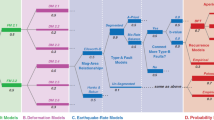Abstract
Earthquake loss estimation is now becoming an important tool in mitigation planning, where the loss modeling usually is based on a parameterized mathematical representation of the damage problem. In parallel with the development and improvement of such models, the question of sensitivity to parameters that carry uncertainties becomes increasingly important. We have to this end applied the capacity spectrum method (CSM) as described in FEMA HAZUS-MH. Multi-hazard Loss Estimation Methodology, Earthquake Model, Advanced Engineering Building Module. Federal Emergency Management Agency, United States (2003), and investigated the effects of selected parameters. The results demonstrate that loss scenarios may easily vary by as much as a factor of two because of simple parameter variations. Of particular importance for the uncertainty is the construction quality of the structure. These results represent a warning against simple acceptance of unbounded damage scenarios and strongly support the development of computational methods in which parameter uncertainties are propagated through the computations to facilitate confidence bounds for the damage scenarios.
Similar content being viewed by others
References
Ambraseys N, Simpson K, Bommer J (1996) Prediction of horizontal response spectra in Europe. Earthq Eng Struct Dyn 25:371–400
Antoniou S, Pinho R (2004) Development and verification of a displacement-based adaptive pushover procedure. J Earthq Eng 8(5):643–661
ATC-40 (1996) Applied technology council, seismic evaluation and retrofit of concrete buildings, vol 1. California, United States
Bommer JJ, Abrahamson NA (2006) Why do modern probabilistic seismic-hazard analyses often lead to increased hazard estimates? Bull Seismol Soc Am 96(6):1967–1999
Bommer J, Spence R, Erdik M, Tabuchi S, Aydinoglu N, Booth E, del Re D, Peterken O (2002) Development of an earthquake loss model for Turkish catastrophe insurance. J Seismol 6(3):431–446
Bommer JJ, Scherbaum F, Bungum H, Cotton F, Sabetta F, Abrahamson NA (2005) On the use of logic trees for ground-motion prediction equations in seismic-hazard analysis. Bull Seismol Soc Am 95(2):377–389
Budnitz RJ, Apostolakis G, Boore DM, Cluff LS, Coppersmith KJ, Cornell CA, Morris PA (1997) Recommendations for probabilistic seismic hazard analysis: guidance on uncertainty and use of experts. U.S. Nuclear Regulatory Commission Report NUREG/CR-6372
Calvi GM, Pinho R, Magenes G, Bommer JJ, Restrepo-Velez LF, Crowley H (2006) Development of seismic vulnerability assessment methodologies over the past 30 years. ISET J Earthq Technol 43(3):75–104
Coburn A, Spence R (2002) Earthquake protection, 2nd edn. John Wiley & Sons
Cotton F, Scherbaum F, Bommer JJ, Bungum H (2006) Criteria for selecting and adjusting ground-motion models for specific target regions: application to Central Europe and rock sites. J Seismol 10:137–156
Crowley H, Pinho R, Bommer JJ (2004) A probabilistic displacement-based vulnerability assessment procedure for earthquake loss estimation. Bull Earthq Eng 2:173–219
Crowley H, Bommer JJ, Pinho R, Bird J (2005) The impact of epistemic uncertainty on an earthquake loss model. Earthq Eng Struct Dyn 34:1653–1685
Douglas J, Bungum H, Scherbaum F (2006) Ground-motion prediction equations for southern Spain and southern Norway obtained using the composite model perspective. J Earthq Eng 10(1):33–72
Fajfar P (1999) Capacity spectrum method based on inelastic demand spectra. Earthq Eng Struct Dyn 28:979–993
FEMA (2003) HAZUS-MH. Multi-hazard loss estimation methodology, earthquake model, advanced engineering building module. Federal Emergency Management Agency, United States
Freeman SA, Nicoletti JP, Tyrell JV (1975) Evaluations of existing buildings for seismic risk - a case study of Puget Sound Naval Shipyard, Bremerton, Washington. In: Proceedings of U.S. national conference on earthquake engineering, Berkeley, United States, pp 113–122
Giovinazzi S (2005) The vulnerability assessment and the damage scenario in seismic risk analysis. PhD. Thesis, Technical University Carolo-Wilhelmina at Braunschweig, Braunschweig, Germany and University of Florence, Florence, Italy
Grossi PA (2000) Quantifying the uncertainty in seismic risk and loss estimation. In: Proceedings of the second Euroconference on global change and catastrophe risk management: earthquake risks in Europe, Austria, pp 1–13
Grünthal G (ed) (1998) European macroseismic scale 1998 (updated MSK-scale). Cahiers du Centre Européen de Geodynamique et de Séismologie, vol 7. Luxembourg
ICBO (1997) 1997 Uniform building code (UBC), structural engineering design provisions. International conference of building officials, vol 2. Whittier, California
Kircher CA, Nassar AA, Kustu O, Holmes WT (1997a) Development of building damage functions for earthquake loss estimation. Earthq Spectra 13(4):663–682
Kircher CA, Reitherman RK, Whitman RV, Arnold C (1997b) Estimation of earthquake losses to buildings. Earthq Spectra 13(4):703–720
Molina S, Lindholm CD (2005) A logic tree extension of the capacity spectrum method developed to estimate seismic risk in Oslo, Norway. J Earthq Eng 9(6):877–897
Newmark NM, Hall WJ (1982) Earthquake spectra and design. Earthquake Engineering Research Institute, EERI
Pinho R, Bommer JJ, Glaister S (2002) A simplified approach to displacement-based earthquake loss estimation analysis. In: Proceedings of the 12th European conference on earthquake engineering, pp 1–11
Porter KA, Beck JL, Shaikhutdinov RV (2002) Sensitivity of building loss estimates to major uncertain variables. Earthq Spectra 18(4):719–743
Scherbaum F, Bommer JJ, Bumgum H, Cotton F, Abrahamson NA (2005) Composite ground-motion models and logic trees: methodology, sensitivities and uncertainties. Bull Seismol Soc Am 95(5):1575–1593
Sousa ML, Campos Costa A, Carvalho A, Coelho E (2004) An automatic seismic scenario loss methodology integrated on a geographic information system. Proceedings of the 13th world conference on earthquake engineering, Vancouver, Canada, Paper No. 2526 (on CD)
Stepp JC, Wong I, Whitney J, Quittemeyer R, Abrahamson NA, Toro G, Youngs R, Coppersmith K, Savy J, Sullivan T, the Yucca Mountain PSHA Project Members (2001) Probabilistic seismic hazard analyses for ground motions and fault displacements at Yucca Mountain, Nevada. Earthq Spectra 17(1):113–151
Toro GR, Abrahamson NA, Schneider JF (1997) Model of strong ground motions from earthquakes in central and eastern North America: best estimates and uncertainties. Seismol Res Lett 68:41–57
Author information
Authors and Affiliations
Corresponding author
Rights and permissions
About this article
Cite this article
Molina, S., Lindholm, C.D. Estimating the confidence of earthquake damage scenarios: examples from a logic tree approach. J Seismol 11, 299–310 (2007). https://doi.org/10.1007/s10950-007-9053-3
Received:
Accepted:
Published:
Issue Date:
DOI: https://doi.org/10.1007/s10950-007-9053-3




